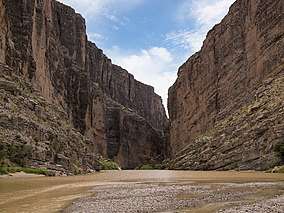Mexico–United States international park
The Mexico–United States international park is a proposed and partially completed cross-border wilderness park straddling the part of the U.S.–Mexico boundary delineated by the Rio Grande.

History
Camacho and Roosevelt in Monterrey, Mexico, in 1943
|
Regan and de la Madrid Hurtado, with their wives, in Washington in 1983.
|
.jpg)
I do not believe this undertaking in the Big Bend will be complete until the entire park area ... on both sides of the Rio Grande, forms one great international park.
When you come to an area as remote and as beautiful as Big Bend, it truly changes your perception of what a border is and what a border can be. There is a line - the river in this case - that politically marks the boundaries of our two countries. But for a tourist, for a park ranger, for a conservationist, and for anyone who has visited this spectacular place, one thing is clear: what we share here – the seamless flow of nature across both banks of the river – is far stronger and far more enduring than what divides us.
— Anthony Wayne, U.S. Ambassador to Mexico, U.S., Mexico Announce Binational Cooperative Conservation Action Plan, Oct 24, 2011[4]
We celebrate putting into actions a model of collaboration for transboundary conservation. The Big Bend-Rio Bravo Natural Area of Binational Interest is a model envisioned by our Presidents; it is a dream shared by many past generations; and a legacy for present and future ones. In sum, it is an example of the best our governments and people can pursue through cooperation and joint work.
— Juan Rafael Elvira Quesada, Environment and Natural Resources Secretary of Mexico, U.S., Mexico Announce Binational Cooperative Conservation Action Plan, Oct 24, 2011[4]
In 1933, the Chamber of Commerce in Alpine, Texas, commissioned a landscape architect to design an international park for the Big Bend region.[1]
In 1935, a U.S. Senator from Texas wrote to U.S. President Roosevelt proposing an international park overlapping the U.S.–Mexico border.[5]
In 1935,[1] or 1936,[6][5] the U.S. and Mexico established a commission to establish Big Bend International Park.
In 1938, the Dallas Morning News reported on proposals for a Big Bend International Peace Park.[7]
In June 1944, Big Bend National Park came into being.[8][9][3] That same month, U.S. President F. D. Roosevelt wrote to Mexican President Manuel Ávila Camacho expressing a desire for the area on both sides of the Rio Grande to form one great international park.[2][3][10] President Camacho agreed with Roosevelt's aim.[6][5]
After Roosevelt died, U.S. President Harry Truman resumed talks with Mexico.[5] In the 1950s, Mexican efforts stopped short of protecting the entire area envisioned, and talks stalled.[5]
In his 1951 essay Chihuahua as We Might Have Been, J. B. Jackson argued for mutual co-operation to restored continuity between the ecosystems either side of the border.[11][3]
In 1983, Mexican President Miguel de la Madrid Hurtado signed an agreement with U.S. President Ronald Reagan to protect, improve and conserve the environment along the border.[6]
In 1994, the Maderas del Carmen protected area was established in Mexico,[6] as was Mexico's Santa Elena Canyon.[12]
In 2000, Cemex established an additional borderland conservation project.
In 2009, Mexico made its side of the Rio Grande and the Ocampo Flora and Fauna south of Big Bend National Park into protected areas.[12]
In May 2010, Mexican President Felipe Calderon U.S. President Barack Obama signed a joint statement pledging both countries' support for cross-border wilderness protection.[2]
In October 2011, U.S. Interior Secretary Ken Salazar and Mexican Environment and Natural Resources Secretary Juan Rafael Elvira Quesada outlined the Cooperative Action for Conservation in the Big Bend/Rio Bravo Region, a plan already underway that identified "the next steps for the continued coordination between the two countries in the protection and preservation of the transnational Big Bend/Rio Bravo region – North America's largest and most diverse desert ecosystem."[10][13][4]
Name
Over the decades, a number of different names have been proposed for the park, including "Big Bend International Peace Park", "Big Bend International Park", "US-Mexico International Park", "Big Bend-Rio Bravo Binational Natural Area", and "Big Bend-Rio Bravo Natural Area of Binational Interest".[14][4]
See also
References
- Casey, Edward S.; Watkins, Mary (1 September 2014). "Up Against the Wall: Re-Imagining the U.S.-Mexico Border". University of Texas Press – via Google Books.
- "Security Worries Overshadow U.S.-Mexico Park Plan". Npr.org. Retrieved 14 March 2019.
- Montemayor, Gabriel Diaz. "Here's a better vision for the US-Mexico border: Make the Rio Grande grand again". The Conversation. Retrieved 14 March 2019.
- "U.S., Mexico Announce Binational Cooperative Conservation Action Plan". Doi.gov. 24 October 2011. Retrieved 15 March 2019.
- Sehgal, Kabir (25 September 2018). "Fandango at the Wall: Creating Harmony Between the United States and Mexico". Grand Central Publishing. Retrieved 14 March 2019 – via Google Books.
- Reicher, Dan W. (14 March 2019). "Opinion - Forget Trump's Border Wall. Let's Build F.D.R.'s International Park". Nytimes.com. Retrieved 14 March 2019.
- "Big Bend National Park visitors worry about Trump's proposed border wall". Dallas News. 29 November 2016. Retrieved 14 March 2019.
- "Big Bend National Park: A Texas Treasure". Learningenglish.voanews.com. Retrieved 14 March 2019.
- Duara, Nigel. "The stunning beauty of Big Bend National Park stretches across two countries. Could it survive a wall?". Latimes.com. Retrieved 14 March 2019.
- "Mexico, United States Pledge To Work Together on Conservation Plan For Big Bend/Rio Bravo Region - National Parks Traveler". Nationalparkstraveler.org. Retrieved 14 March 2019.
- Jackson, John Brinckerhoff (1 March 2000). "Landscape in Sight: Looking at America". Yale University Press. p. 43. Retrieved 14 March 2019 – via Google Books.
- Tribune, The Texas; Garcia-Ditta, Alexa (26 April 2010). "Peace Bend?". The Texas Tribune.
- "Photos: Cooperative Action for Conservation in the Big Bend/Rio Bravo Region". Doi.gov. 25 October 2011. Retrieved 15 March 2019.
- "International Park – Forgotten Frontiers". Forgottenfrontiers.com. Retrieved 15 March 2019.

